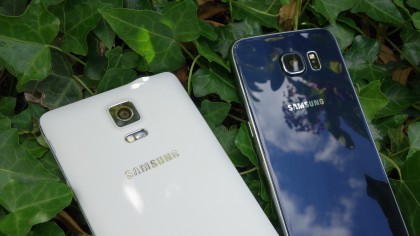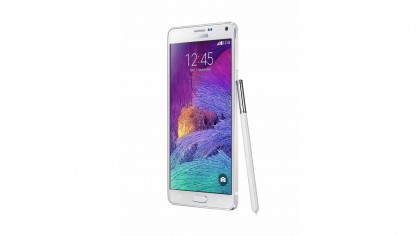Samsung Galaxy S6 vs Samsung Galaxy Note 4

The Samsung Galaxy S6 is undoubtedly the best phone in the S range, but the Samsung Galaxy Note 4 represents the best of a premium line that runs parallel to it.
Released at a different time of the year, and marketed to a slightly different "power" user crowd, the Galaxy Note series has always been able to avoid treading on Galaxy S toes by keeping its distance.
But with the Galaxy S screen size seemingly hitting a Note-shaped glass ceiling (the Galaxy S6 is the first in the range not to get a bigger display), and the high-end components used steadily converging, there's more reason than ever to compare the two current models.

While it might seem as if the Samsung Galaxy S6's premium design came out of nowhere upon its April 10 2015 launch, it was actually the culmination of a rapid iterative process started with the Samsung Galaxy Alpha and continued through the Galaxy Note 4.
With only six months separating these two phones, it's a fascinating comparison to make - particularly now that the Galaxy S6 is arguably encroaching on the Galaxy Note 4's slightly more businessy target market.
Key features
It would be a mistake to say that the Samsung Galaxy S6 is all about the design - it's got far more substance than that. But the way it looks and feels is undoubtedly the biggest talking point here.
A large part of that is down to what went before. Samsung used to make solid, well built, functional but deeply unlovable handsets. They were built to survive everyday knocks and spills rather than to wow with their good looks.
Sign up for breaking news, reviews, opinion, top tech deals, and more.
In the Galaxy S6, here was an Android phone that instantly strutted to the top of the Android design table, ready to mix it with the iPhone 6.
The Galaxy Note 4, as befits its 'tweener status on the release schedule, is a much better looking and feeling device than the Galaxy S5, but isn't up to the standard of the Galaxy S6. It's, well, a bit of a mix of the two.

It's got the metal frame of the Galaxy S6 (albeit a squarer, less attractive version), but the slightly cheap faux leather plastic back of the Galaxy S5 (minus the plaster-like dimples). It's also –- and there's really no getting away from this – a bit of a chunky monkey. This one will sit uncomfortably in any trouser or light jacket pocket.
Of course, I'd back the Galaxy Note 4 in a drop despite its heftier body. It must be something to do with the Galaxy S6's twin glass surfaces (Gorilla Glass 4), as well as its aggressively jutty-outy camera.
Both phones make a virtue of their incredible QHD Super AMOLED displays. The Galaxy S6's is the smaller yet more pixel-packed at 5.1-inches, while the Galaxy Note 4's 5.7-inch unit gets to stretch its legs more. Indeed, I'd argue that the Galaxy Note 4 is a better showcase for true 2K content.

However, the brightness and colour accuracy of the Galaxy S6 reflect its next-gen status.
Another shared key feature is the camera. When the Galaxy Note 4 launched last year, it one-upped the Galaxy S5 by adding OIS (optical image stabilisation) to an already robust 16-megapixel shooter.
But the Galaxy S6 is another level on from that. It too is a 16-megapixel camera with OIS, but it throws in a whole bunch of other improvements, including an f/1.9 aperture, to push image quality to the next level.

Another ostensibly shared feature that's actually far better on the Galaxy S6 is the fingerprint sensor, which can be used to unlock both phones. While both are mounted under the home button, the Galaxy Note 4 system requires a fiddly and unreliable touch-and-swipe to activate.
The S6, meanwhile, has an iPhone-like press-to-activate system that works much better than before. Having said that, I've noticed more failures as time goes on and I'm less conscientious about placing by thumb just-so on the sensor.
The Galaxy Note 4's biggest distinction from the Galaxy S6 – and most other phones for that matter – is its S Pen stylus.

Opinion remains divided as to its true usefulness, but the S Pen is undoubtedly the best integrated and most sophisticated stylus in the business. It makes the kind of virtual pens you pick up for the iPad look as dumb and unoptimised as they are.
It also provides the one major design difference between these two great phones apart from their size.

Jon is a freelance journalist who has been covering tech since the dawn of the smartphone era. Besides TechRadar, his words and pictures have appeared in The Telegraph, ShortList, Tech Advisor, Trusted Reviews, Expert Reviews, and more. He largely covers consumer technology, with a particular focus on smartphones and tablets. However, he's also been known to dabble in the worlds of entertainment and video games.